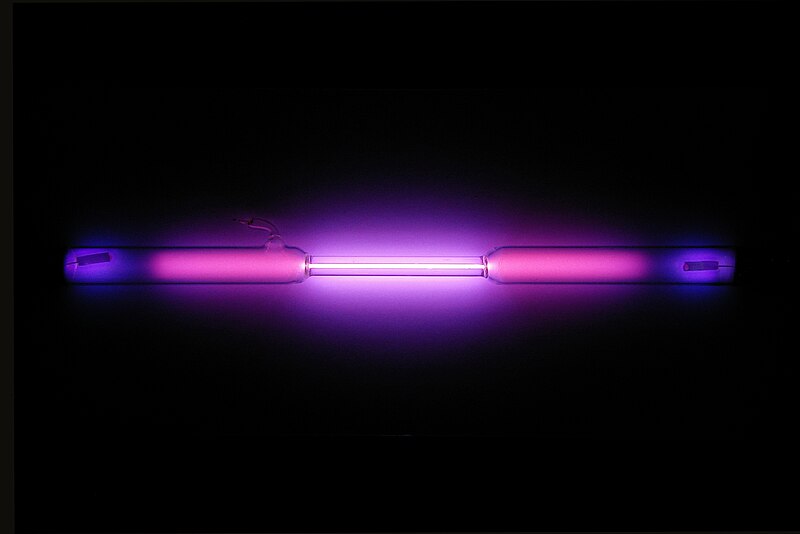
Discharge tube filled with argon, image from Wikimedia Commons
The inertia of argon is one of its most outstanding characteristics. This property, combined with its abundance in the Earth's atmosphere, has allowed it to be used as a reference gas in the calibration of scientific equipment, especially in the field of mass spectrometry and gas chromatography. Also, due to its stability, it is an excellent filler gas for lamps, such as those used in high-intensity lighting or in the production of laser devices. Argon's purity and stability are also crucial for the production of semiconductors and advanced materials, helping our society advance technologically.
Another relevant application of Argon is found in geological dating. The potassium-argon dating method is based on the radioactive decay of the isotope potassium-40 (40K) into Argon-40 (40Ar). The measurement of the amount of Argon accumulated in a rock sample allows to determine the approximate age of the geological formation. This method is essential to establish the chronology of geological and archaeological events, providing crucial information to understand the evolution of our planet and the geological processes that have shaped it.
Argon is also relevant in particle physics. Argon is used as a radiation detector in low-temperature environments, especially in experiments looking for subatomic particles and dark matter. It has been used to develop sensitive detectors capable of tracking high-energy particles and studying astrophysical phenomena thanks to its ability to emit light when it interacts with charged particles.
Astronomical research has also focused on Argon. Astronomers have obtained important information about the chemical composition and physical conditions of stars and galaxies by detecting the characteristic light emission from Argon in the spectrum of celestial objects. In inductively coupled plasma spectroscopy (ICP-MS), Argon was also found to be used as a transport gas, to bring solid samples to a gaseous state and analyze their atomic components with great precision.
Argon plays an essential role in various areas of science, from basic research to advanced technological applications. Its inert nature, abundance in the atmosphere, and unique capabilities make it valuable for understanding and advancing knowledge in multiple scientific fields.
The singularity of this reader friend is that the Argon offers tools and knowledge that have been essential for the progress of humanity in a variety of areas. His silent and continuous presence has shown that even the seemingly simplest elements can hide fascinating secrets that are discovered through scientific exploration. In order to continue taking advantage of the benefits of Argon and other key elements on our path towards a brighter and more enriching future, as a society, we must continue to value and support scientific research.
Sure, here's a practical example using Argon in the context of Inductively Coupled Plasma Spectroscopy (ICP-MS). In this case, we will simulate the detection and analysis of elements in a solid sample using an Argon plasma mass spectrometer as the transport gas.
Exercise: ICP-MS to analyze elements in a sample
Step 1: Prepare the sample
Let's imagine that we have a mineral sample that we want to analyze to determine the concentration of different elements. To achieve this, it is necessary to crush and homogenize the sample to obtain an accurate image of its composition.
Step 2: Team Training
We turn on the inductively coupled plasma mass spectrometer (ICP-MS) and set it to use Argon as the carrier gas. We adjust the plasma parameters to find the ideal temperature and gas flow.
Step 3: Presenting the sample
We place the solid sample in the ICP-MS introduction system through a nebulizer or an ablative laser, depending on the nature of the sample.
Step 4: Ionization and analysis
Argon plasma, which reaches extremely high temperatures, breaks down the sample into positively charged atoms and ions. These ions are directed towards the mass spectrometer, where they are separated and analyzed according to their mass/charge ratio (m/z).
Step 5: Detection and quantification
Each element produces a characteristic signal in the mass spectrum, and the ICP-MS detectors record these signals. The intensity of the signal is related to the concentration of the element in the sample. Based on the signals detected, we quantify the elements present.
Step 6: Results and interpretation
Once the analysis is finished, we obtain the results that indicate the concentration of the elements present in the sample. These data allow us to make an interpretation about the composition of the sample and, in the case of minerals, can provide information about the mineralogy and the presence of valuable minerals or contaminants.
Importantly, inductively coupled plasma spectroscopy (ICP-MS) with Argon as carrier gas is a highly accurate and sensitive technique for the analysis of elements in various samples. Its applicability ranges from geology and materials science to quality control in industry and environmental science research.
This exercise illustrates how Argon, as an inert and abundant gas, plays an essential role in a sophisticated analytical technique that has revolutionized the ability to detect and quantify elements in various samples, providing valuable information for science and technology in multiple fields.
Bibliographic Reference
Argon by Kristi Lew, 2008.
The Noble Gases: Helium, Neon, Argon, Krypton, Xenon, Radon, by Adam Furgang, 2010.
Nicely illustrated!
Carbon is very essential inert gas.
I forgot maximum characteristics.
Thanks for talking about it.
Thank you for your comment, well the unique thing about it all is the scientific disclosure
Thanks for your contribution to the STEMsocial community. Feel free to join us on discord to get to know the rest of us!
Please consider delegating to the @stemsocial account (85% of the curation rewards are returned).
You may also include @stemsocial as a beneficiary of the rewards of this post to get a stronger support.